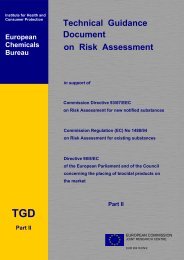Challenges of Regulation and Risk Assessment of Nanomaterials
Challenges of Regulation and Risk Assessment of Nanomaterials
Challenges of Regulation and Risk Assessment of Nanomaterials
You also want an ePaper? Increase the reach of your titles
YUMPU automatically turns print PDFs into web optimized ePapers that Google loves.
5. EXPOSURE ASSESSMENT<br />
5.1. Summary record<br />
Exposure is a central concept in risk assessment: if there is no exposure, there is no risk. Therefore,<br />
exposure assessment studies for nanomaterials (NM) are a cornerstone to carry out reliable risk<br />
assessment. However, there are very few studies so far <strong>and</strong> mostly concentrated in the occupational<br />
area. The goal <strong>of</strong> this session was to present some examples <strong>of</strong> exposure measurement <strong>and</strong><br />
estimation, hoping to have more <strong>of</strong> these studies available in near future.<br />
Among other exposure pathways, the consumer exposure via spray products is considered a priority,<br />
since it could lead to significant acute exposure to NM. In the market there are several products to<br />
treat surfaces obtaining a nan<strong>of</strong>ilm inducing the loto effect (increased hydrophobic properties <strong>of</strong> the<br />
surfaces). In general the goal is to simplify cleaning <strong>and</strong> to reduce the amount <strong>of</strong> cleaning substances<br />
used. Not all <strong>of</strong> these products contain actual NM, but they were considered because <strong>of</strong> the<br />
generation <strong>of</strong> a nan<strong>of</strong>ilm. This case shows how it is somewhat difficult to define <strong>and</strong> identify<br />
‘nanoproducts’ that are on the market: for example sometimes the content <strong>of</strong> a NM is not declared,<br />
<strong>and</strong> sometimes the use <strong>of</strong> a NM in the product is not necessary to decide that we are dealing with a<br />
nanoproduct. A case study presented during the session showed the amount <strong>and</strong> form <strong>of</strong> NM<br />
released during the use <strong>of</strong> various spray products commercialized in Denmark. Exposure was<br />
measured in laboratory, simulating the actual use. According to these results, nanoparticles are<br />
formed in air, but after short time (few minutes) the number <strong>of</strong> particles decreased. During the<br />
discussion it was suggested that decrease <strong>of</strong> particle number could be related to adsorption <strong>of</strong><br />
particles to the walls <strong>of</strong> the chamber used in the test, but this hypothesis was not checked. Anyway,<br />
size development during <strong>and</strong> after exposure was monitored. Using the spray can, a high nucleation<br />
was observed, with formation <strong>of</strong> bigger particles in short time, maybe due to the presence <strong>of</strong> O3. For<br />
two <strong>of</strong> the products an inhalation toxicity test on mice was performed, <strong>and</strong> for one product it was<br />
found an unacceptable risk at concentrations very near the concentrations found during normal use,<br />
but related to a chemical compound which was not a NM. During the discussion it was highlighted<br />
that besides inhalation also oral exposure could play a big role in consumer exposure. According to 1<br />
study, oral intake is 1000 to 10000 higher than inhalation, <strong>and</strong> the translocation from gut to blood is<br />
significant. Therefore there is the need to have more data about this route <strong>of</strong> exposure, especially<br />
about transit time <strong>and</strong> translocation. However, if it is important to collect more experimental<br />
exposure data measured in realistic conditions, it is not practical to expect that exposure will be<br />
measured in all possible conditions <strong>and</strong> for all products. As it happened for conventional chemicals,<br />
also for NM it is essential that modelling tools are made available to risk assessors <strong>and</strong> regulatory<br />
bodies in order to screen the possible workers, consumers <strong>and</strong> environmental exposure. Current<br />
models, e.g. ECETOC TRA, ConsExpo, St<strong>of</strong>fenmanager, are still based on conventional chemical<br />
parameters, <strong>and</strong> the identification <strong>of</strong> properties <strong>of</strong> NM that could influence the exposure <strong>and</strong> their<br />
parameterization are lacking. To try to underst<strong>and</strong> the applicability <strong>of</strong> the human exposure models to<br />
NM, available models where applied to some exposure scenarios for workers, <strong>and</strong> brief<br />
considerations where made for consumers. In this last case, both ECETOC TRA <strong>and</strong> ConsExpo are in<br />
principle applicable to estimate the inhalation <strong>of</strong> NM, but there are some limitations due to the fact<br />
that values for some parameters are defaults not addressing NM specificities, <strong>and</strong> that agglomeration<br />
is not taken into account. For workers, a thorough assessment <strong>of</strong> suitability <strong>and</strong> performance check<br />
was carried out. According to the results, the models' basic concepts are suitable, but there are issues<br />
related to the variable categories (e.g. dustiness) that should be refined <strong>and</strong> adapted to NM, to<br />
exposure metrics that probably are not always optimal. Finally, there is no calibration for NM. Models<br />
were applied in few exposure scenarios using real conditions, <strong>and</strong> the results were compared to<br />
experimental exposure data measured in the same conditions to check the model performance. The<br />
35








